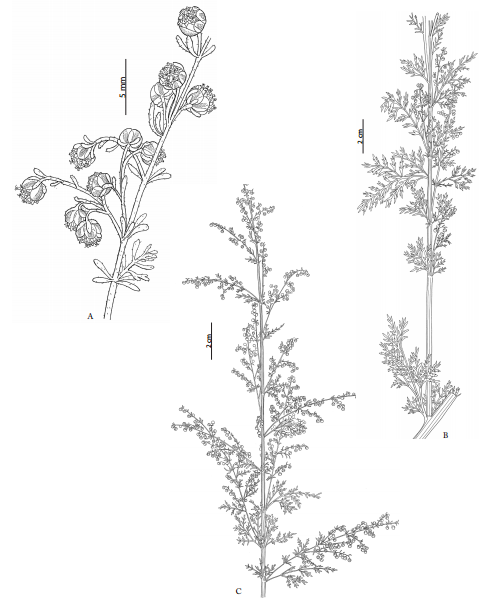|
Standardized Common
Name: Sweet
Wormwood
Other Common Names: Annual Sagewort,
Annual Wormwood, Sweet Annie
Family: Asteraceae
(Compositae)
Taxonomy: As noted under Artemisia absinthium L., Artemisia is a very
diverse genus whose taxonomy is incompletely understood. Artemisia annua
is one of perhaps 170 species native to China. It occurs widely in Eurasia and
has been naturalized on other continents, especially North America. Chemical
variation correlated with geographic origin has been reported.
Description: Annual or biennial
herb. Stem erect or spreading, branching, 0.3–1.5(–3.0) m high, glabrous.
Leaves alternate, basally crowded, petiolate, 1–3-pinnatifid or pinnatisect,
3–10 cm long; ultimate segments lanceolate, acute; both surfaces glabrous or
nearly so. Inflorescence a panicle or raceme, to 50 cm long, branches spreading
or recurved; bracts leafy; heads numerous, small, widely spaced, pedicellate,
often drooping. Heads hemispherical, greenish-yellow, with all florets tubular
but ray florets female only, disk florets hermaphroditic. Involucre
hemispheric, 1–2 mm high, glossy, of 8–14 bracts (phyllaries), the outer narrow
and green, the inner with green midrib and scarious margins. Receptacle hairless.
Ray florets 5–12+; corolla oblique, <1 mm long, glandular. Disk florets
5–20; corolla 1 mm long, 5-toothed, glandular. Fruit an achene, 1 mm long,
broadening at top, smooth, glabrous, without pappus.
Parts
in Commerce:
Whole herb
Identification:
- Stems hairless,
longitudinally striated, green or older parts sometimes reddish
- Leaves 3–10 cm
long, (1–)3-pinnately divided or lobed, often resembling a fern’s frond;
the smallest divisions lanceolate, <1 mm broad, <1 cm long
- Leaves nearly
hairless on both surfaces
- Inflorescence a
loose leafy panicle; bracts resembling vegetative leaves, smaller and less
divided
- Heads numerous,
round, often drooping, to 2 mm high, 2–3 mm in diameter
- Involucre
hemispheric, glossy; bracts ovate, at least the inner ones having a green
midrib and dry margins
- Receptacle a
minute, hairless conical knob
- Florets all
greenish yellow; corollas ca. 1 mm long, more or less tubular and mostly
5-toothed, hairless except for small yellow glands
- Odor aromatic,
sweet
- Taste aromatic,
slightly bitter
Adulterants: Adulteration is not
known to be a problem. Cultivated material is preferred as it is thought to be
more potent than wild-collected material, especially outside Asia. However,
wild material from North America is found in commerce. Artemisia annua
closely resembles the North American A. biennis Willd. The latter has
nearly sessile heads borne on crowded spikelike panicles; the leaves are mostly
bipinnately lobed or divided; and it has little or no sweet odor.
References:
Fernald ML. Gray’s Manual of Botany, 8th ed. New York: American Book
Company; 1950:1519–1524.
Ferreira JFS, Janick J. Floral morphology of Artemisia
annua with special reference to trichomes. Int J Plant Sci.
1995;156:807–815.
Hall HM, Clements FE. The phylogenetic method in
taxonomy: the North American species of Artemisia, Chrysothamnus,
and Atriplex. Washington, DC: Carnegie Institute of Washington;
1923.
Pharmacopoeia Commission
of PRC, eds. Pharmacopoeia of the People’s Republic of China, English ed., vol. 1. Beijing: Chemical
Industry Press; 1997:84–85.
Tutin TG, Persson K, Gutermann W. Artemisia.
In: Tutin TG, Heywood VH, Burges NA,
et al., eds. Flora Europaea. Vol. 4. Cambridge: Cambridge University
Press; 1976:178–186.
 Figure 10: a–c, Artemisia annua inflorescence and habit.
|